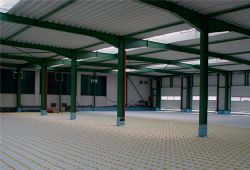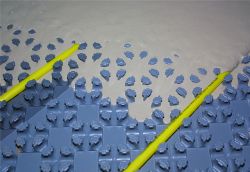Underfloor heating is a perfect partner for air-to-water heat pumps, according to Andrew Crown. Here, he looks at the principles of best practice during installation
A recent report from the Carbon Trust estimated that a third of a building's energy consumption is attributed to heating and hot water. More interestingly, however, the report also highlights that UK organisations could be saving £400 million a year by following simple energy saving measures and so it's imperative that buildings, new and old, are energy efficient.

Air-to-water heat pumps are acknowledged throughout the industry to be a cost-effective heat source for commercial buildings - especially those in off-gas areas. There is a wide range of heat emitters available such as low temperature radiators and fan convectors. But the fact remains that, for new build and retrofit situations, underfloor heating and heat pumps are a perfect combination.
The cost of installing an air-towater heat pump is comparable with that of a traditional oil-fired boiler and with high coefficients of performance (CoPs), running costs can be hugely reduced compared with those of traditional fossil fuels, making them ideal for locations where the building is not connected to the gas supply. When partnered with a low temperature heat emitter, such as an underfloor system, efficiencies are further maximised.
Specifying an air-to-water heat pump to supply warmth to underfloor heating is about more than the costsavings alone. Heat pumps are well suited to underfloor systems in just about every respect. Their versatility and flexibility top the list of recommendations, as they can be installed in most new build sites easily and retrofit is also an option.
When specifying heat pumps together with UFH for new build applications, the additional carbon and running cost savings are recognised in energy assessments (SAP and BREEAM). The sustainability credentials that a combined heat pump/underfloor system offer a serious marketing advantage, as companies are striving to bring down their emissions to meet targets and reduce their running costs.
Going well together
Why do heat pumps and underfloor heating go so well together? The efficiency of air-to-water heat pumps increases as the emitter flow temperature decreases. The low temperature UFH radiant heating system uses a larger floor mass to emit heat via a network of water filled pipes, and effective results can be achieved with lower design flow temperatures, thereby maximising the system's efficiency. Utilising the larger heating area in a commercial space - namely the entire floor surface area - together with a low flow temperature, can generate the equivalent heat output as relatively small and focused surfaces of a wall-mounted radiator with higher flow temperatures.

This makes underfloor heating, which can be designed to operate most efficiently at low flow temperatures of circa 35 deg C, ideally suited to low temperature air-to-water heat pumps in their most efficient operating temperature range. Although the flow temperatures for underfloor heating applications will vary depending on factors such as floor construction and coverings, as well as the levels of insulation at the site, typically the flow temperature in a new build application will be in the range of 35-45 deg C, which is considerably lower than the 70-80 deg C seen in a conventional radiator system.

Different approach is needed
Additionally, underfloor heating systems combined with air-to-water heat pumps are simple to install and the constant temperatures that they provide can increase comfort levels to users. However, it may be necessary to educate end users that a different approach to their heating is needed.
Staff need to be made aware of the different ways the heat is emitted so that they become used to a constant, comfortable temperature level being maintained. Operating longer running hours with set-back temperatures for unoccupied periods suits the UFH system and the heat pump system. This is preferable to maintain efficiencies, and is different to high temperature boiler-radiator systems where occupants and managers are more used to manually adjusting the temperature settings to full blast in an inefficient manner several times throughout the day.
In large commercial building areas, typically with high vaulted ceilings, the UFH is also providing heat where it is needed, that is in the 2m zone from the floor height.
Underfloor heating systems are simple to integrate with air-to-water heat pumps and can offer considerable versatility in the design of facilities, especially in situations where wall-mounted radiators would be intrusive or inconvenient.
As the heat output from an underfloor heating system is so strongly influenced by factors such as insulation, intended floor coverings and the materials used in the building's construction, it is always recommended that design calculations are carefully assessed before specification and installation. This will also ensure that the system will work correctly and at optimum levels.
// The author is commercial manager for heating and renewables at Daikin UK //